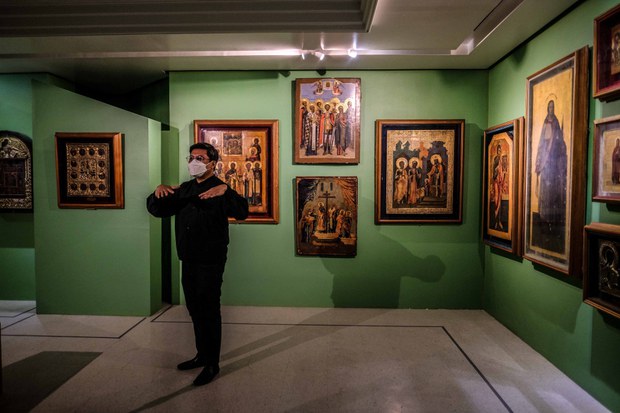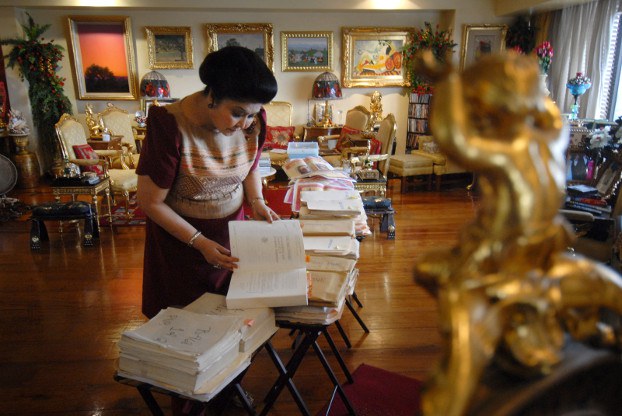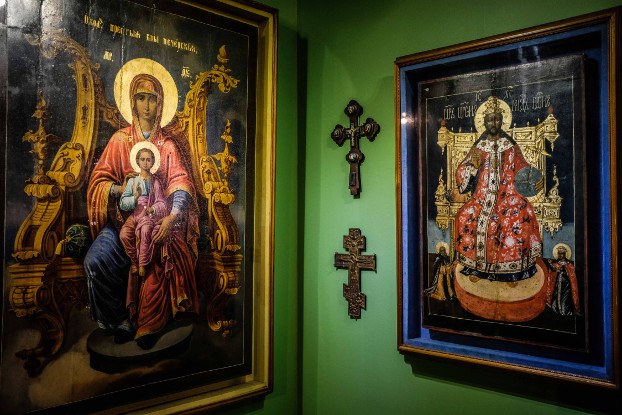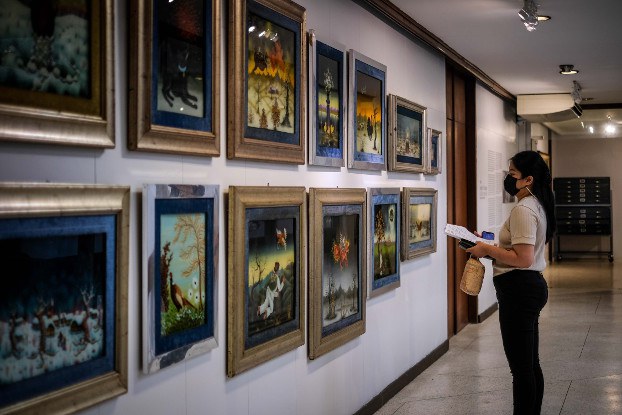Art seized from Marcoses on display at Philippine museum
2022.08.30
Manila
 Dr. Patrick Flores, curator of the Vargas Museum at the University of the Philippines in Quezon City, shows artwork seized from the Marcos family, July 23, 2022.
Dr. Patrick Flores, curator of the Vargas Museum at the University of the Philippines in Quezon City, shows artwork seized from the Marcos family, July 23, 2022.
A Manila-area museum is exhibiting paintings and artifacts from a priceless collection that belonged to the late dictator Ferdinand Marcos and his wife but which they allegedly acquired with stolen money.
Meanwhile, the government agency that recovered the art and whose task is to return to the Filipino people billions of dollars believed to have been looted by the Marcoses from state coffers is in danger of being shut down now that the dictator’s namesake son is the country’s president.
The Presidential Commission on Good Government was established in 1986 by then-President Corazon Aquino who succeeded the elder Marcos after a “people’s power” uprising toppled his regime. Now, congress is considering cutting funding and folding the PCGG into another government agency.
The purpose of the art show, titled “PCGG Artworks Collection: Objects of Study,” is to let people confront recent history, said Dr. Patrick Flores, curator of the Vargas Museum, which is housed at the Diliman campus of the University of the Philippines in Quezon City. He noted that the exhibit, which is to be displayed indefinitely, is not tied to the most recent election that saw Ferdinand Marcos Jr. win the presidency in a landslide.
“Well it was not timed to coincide with the ascendancy of the son of Ferdinand Marcos. This has been in the works since last year. I don’t know if the universe conspired,” Flores told BenarNews.
Along with winning back the presidency this year, the Marcos family has power in congress. The new president’s sister is a senator and a cousin is the speaker of the House, while Marcos Jr.’s son was elected in May and holds a senior House post.
“There’s an impression that art is insulated from politics, but here you see quite an intricate entanglement between power and culture,” Flores said.
“It’s an important time to confront the historical implications of their continuing presence in Philippine life,” he said of the Marcos family.
While the exhibit forces the public to confront the nation’s recent political history, the collection can be viewed “as part of the global heritage of art,” he argued.
The importance, Flores said, “lies in the aesthetic dimension of the collection as well as its complex political history.”

The exhibit showcases a portion of the 500 or so works of art collected by the agency.
Flores described it as a “diverse collection” of religious artifacts as well as paintings from the former Soviet Union, including Yugoslavia, as well as from Italy.
Dictator Ferdinand Marcos, who held power from 1965 to 1986, died in Hawaii three years after his family fled the Philippines. His widow, Imelda, son Ferdinand, and two daughters, Imee and Irene, were eventually allowed to return home.
Imelda Marcos, who styles herself as a patron of the arts, said she acquired the art for the Metropolitan Museum of Manila, which at the time was intended as a prime venue for exhibitions to promote world cultures.

Former PCGG commissioner Ruben Carranza, who is based in the United States, said Imelda Marcos acquired much of the art in 1974 when she went on a buying spree to impress the world about her sophistication.
“There was nothing artistic nor cultural in her intentions. It was simply to hide her insecurities and to simultaneously pretend that the dictatorship was a sophisticated regime while it was torturing Filipinos and stealing from them,” he told BenarNews via email.
Since the family’s return, Imelda Marcos was convicted of large-scale graft, but with her son in the presidential palace, it is unlikely she will be incarcerated.

Calls to abolish PCGG
Political allies of the Marcoses, meanwhile, have renewed calls to abolish the PCGG, the agency created by Corazon Aquino through Executive Order No. 1.
Last week, members of the House of Representatives argued that it would be more practical if the PCGG was absorbed, possibly by the Office of the Ombudsman or the Department of Justice, in line with the government’s downsizing efforts.
“Sorry to say, but as I see it, you have outlived your usefulness. The management of government property can be handled by other agencies,” Cavite Rep. Elpidio Barzaga Jr. said. “PCGG has existed [for] too long.”

Previous bills sought to merge it with the Office of the Solicitor General, the country’s counsel.
PCGG chairman John Agbayani defended his office by telling lawmakers that it contributed U.S. $10 million (562.6 million pesos) or more to the nation’s coffers annually. In 2022 alone, he said the agency had remitted $15 million (844 million pesos).
The amount of the Marcos family’s ill-gotten wealth was estimated at $10 billion (562.6 billion pesos) in 1986, when the family fled the country. Authorities have reported that about $658 million in money deposited in Swiss bank accounts had been recovered.
Progressive lawmakers sided with the PCGG, saying the wealth, which they pegged at $38.4 billion (2.16 trillion pesos) in current valuation, could be used to help Filipinos.
During his campaign, Marcos said he wanted the PCGG to have a larger mandate and budget to focus, not only on his family, but in fighting graft and corruption.

After all, “there’s nothing they can do” for final judgments and recoveries, he said.
“For pending cases, we just expect that the president will just recognize the doctrine of separation of powers in the government and he will not waste away the trust and confidence bestowed on him by 30 million voters by doing something which is offensive to morals and good conduct,” Agbayani said.







